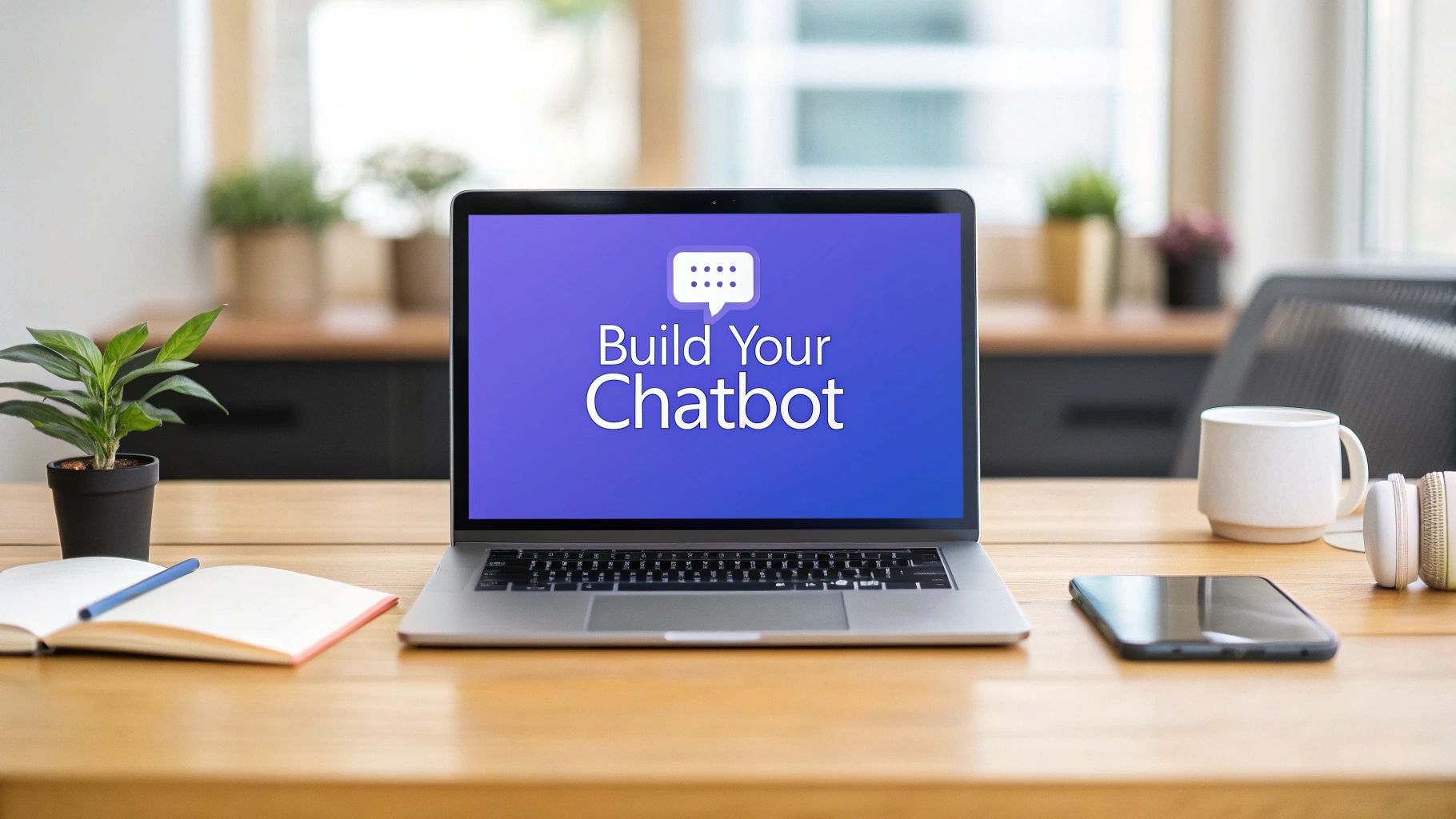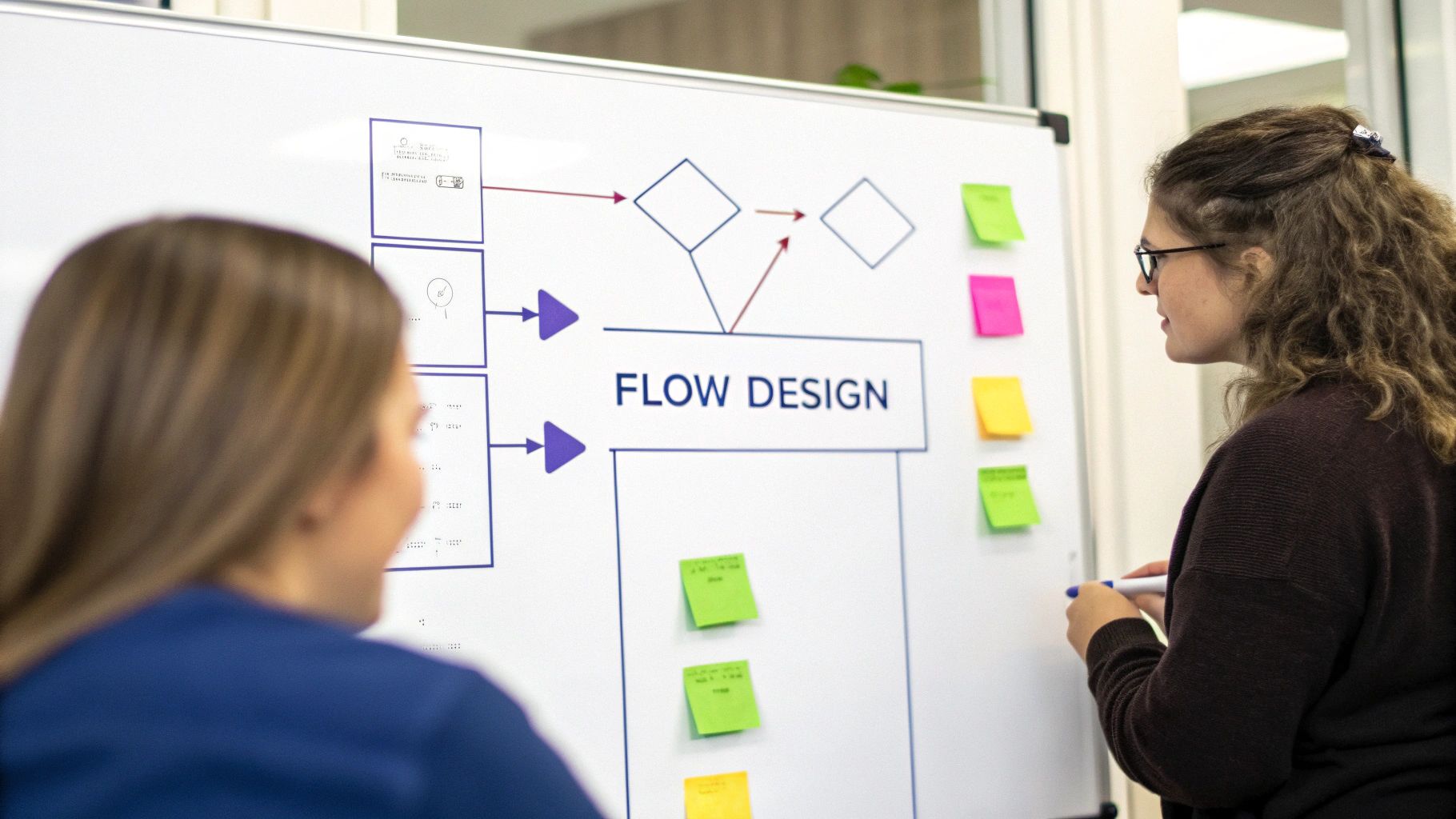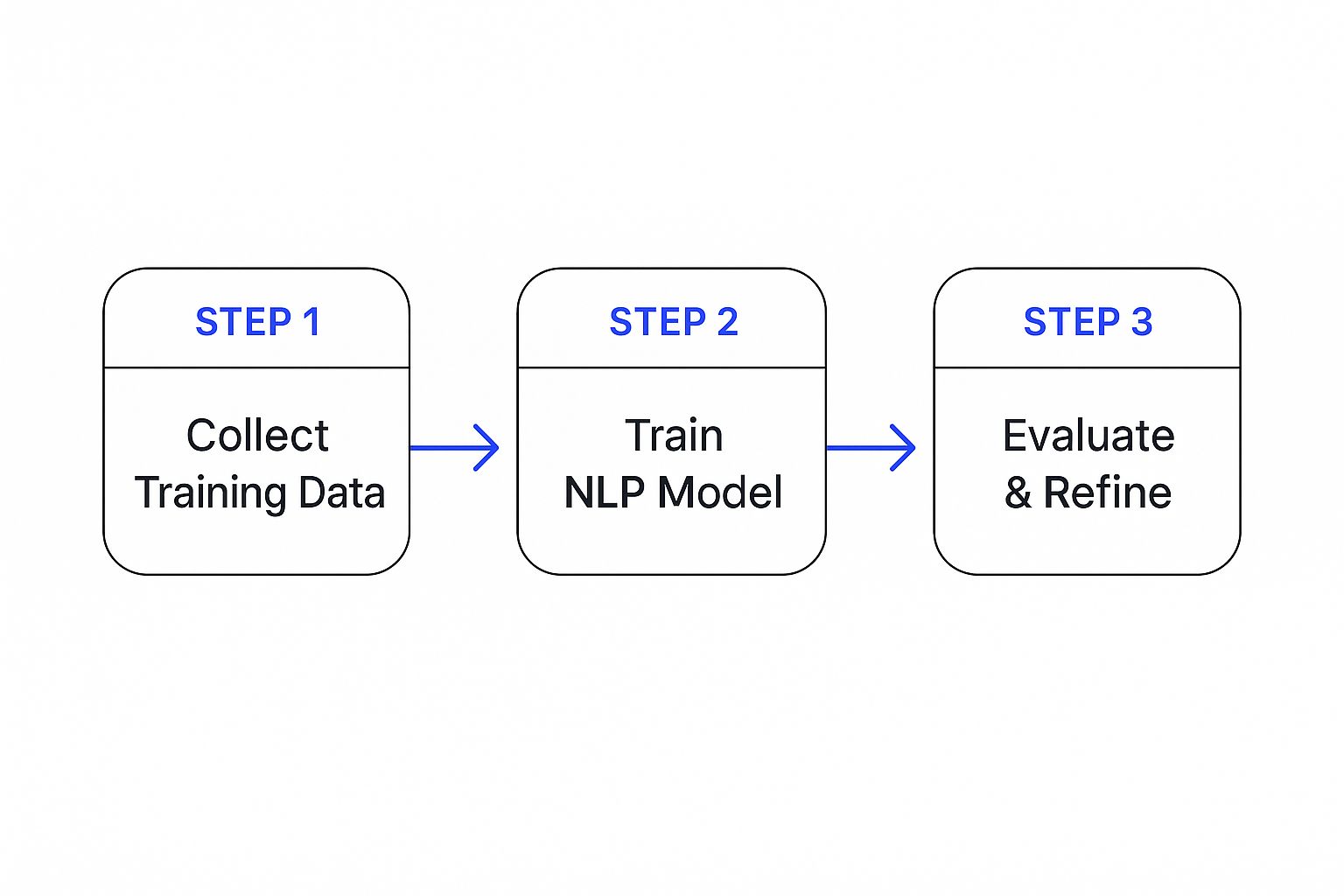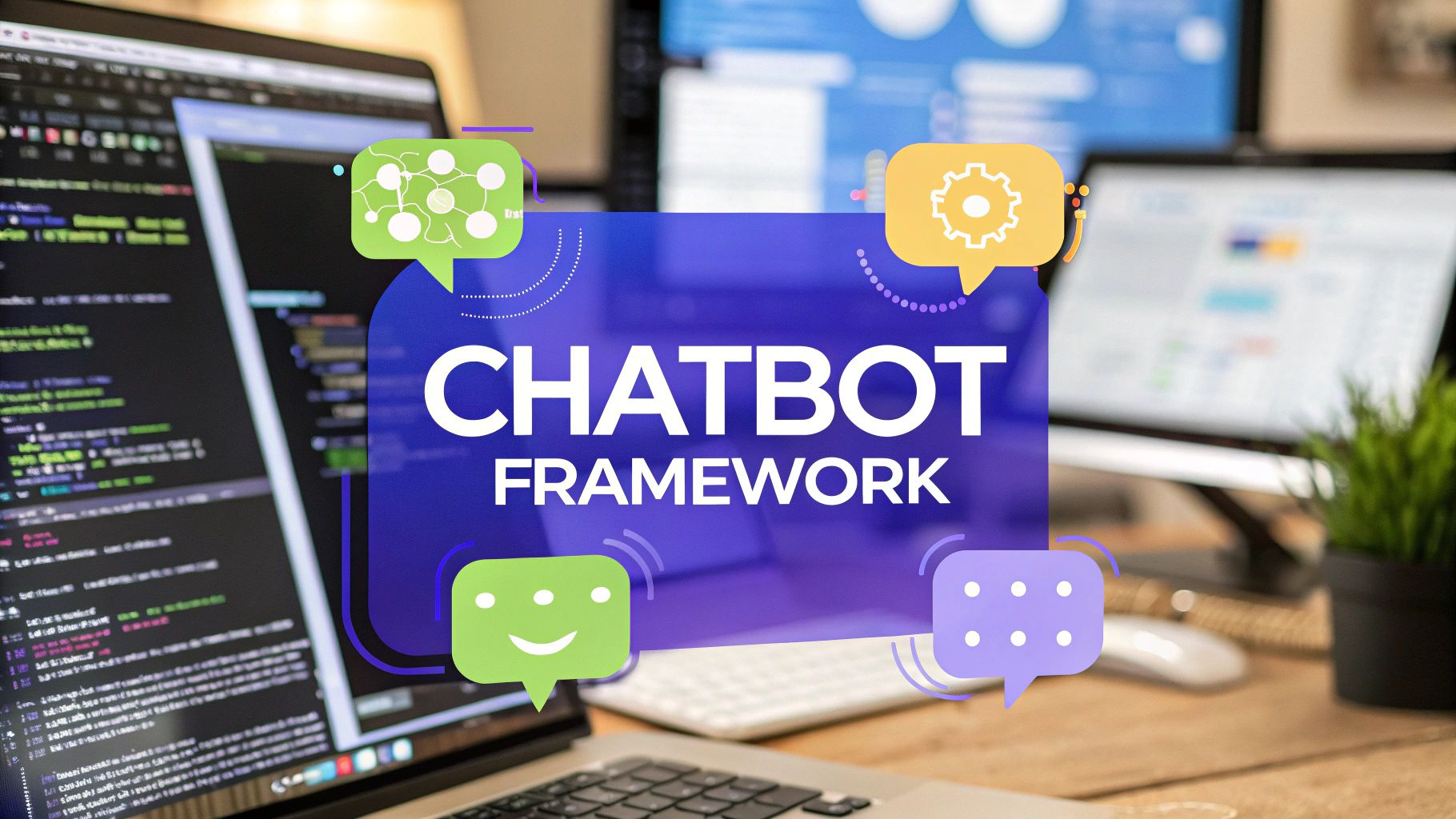Building a Chatbot: How to Create an Engaging Customer Assistant
Learn how to build a chatbot that enhances customer experience. Get tips on planning, data, deployment, and scaling—all in one guide.

Building a chatbot means turning raw information, like common customer questions and support docs, into an interactive assistant that delivers instant support and keeps users engaged. It involves defining a clear purpose, gathering the right training data, mapping out a conversation, and then using a platform like Chatiant to bring it all to life.
Why a Well-Built Chatbot Matters for Your Business

Before we jump into the "how-to," let’s get clear on the "why." Why is a well-built chatbot such a smart move for any business today? Simply put, customers expect fast, on-demand answers, and a thoughtfully designed chatbot delivers exactly that.
It provides 24/7 support, resolving common queries the moment they come up, long after your team has logged off.
This immediate help has a direct impact on the customer experience. Instead of waiting around for an email reply or sitting on hold, users get the info they need right away. This also frees up your human support agents to focus on the more difficult, high-value issues that truly need a personal touch.
More Than Just Answering Questions
Modern chatbots are much more than simple Q&A machines. They have evolved into proactive tools for business growth, helping with everything from lead generation to closing sales. A bot can qualify leads by asking smart questions, guide users to the perfect product, and even schedule appointments automatically.
This capability turns a passive website visitor into an active, engaged lead. By creating these personalized interactions, you build a stronger connection with your audience and guide them through your sales funnel far more effectively. If you're looking to take this even further, it's worth exploring custom solutions that can align an AI's capabilities directly with your business goals.
A thoughtfully designed chatbot acts as a digital extension of your brand. It is a consistent, reliable touchpoint that reflects your company’s voice and commitment to customer satisfaction.
Comparing Popular Chatbot Development Platforms
Choosing the right platform is a huge part of building a great chatbot. Each one has its own strengths, so it really depends on what you need, whether that's simplicity for a small business or deep customization for an enterprise team.
Here's a quick look at some of the top players and who they're best for:
The best platform is the one that fits your team's skills and your project's goals. For many, a tool like Chatiant hits the sweet spot between power and ease of use.
The Financial and Operational Impact
The rapid growth of the chatbot market really underscores its business value. The market is projected to hit around $15.57 billion by 2025, a massive jump from $2.47 billion in 2021. This isn't just hype; it is driven by real operational efficiencies and cost savings.
Companies that use chatbots are estimated to save up to $11 billion and nearly 2.5 billion labor hours each year. You can dig into more of these trends on Exploding Topics if you're curious.
At the end of the day, investing time in building a chatbot the right way pays off. It is not just about automating replies; it is about creating a smarter, more efficient way to interact with your customers. The result is a better experience for them and a more streamlined workflow for your team.
Mapping Your Chatbot’s Purpose and Conversation Flow
A great chatbot starts with a clear plan, not with code. Before you get into the technical side of things, you first need to map out its purpose and how it will actually talk to users. This is the foundation; it is all about designing the user journey first.
Think of it like building a house. You wouldn't start ordering bricks and windows without a blueprint. In the same way, your chatbot needs a design that outlines its main goal and the paths a conversation might take to get there.
Defining Your Chatbot's Core Goal
First up, ask the most important question: What is the one primary job this chatbot needs to do? Trying to build a bot that does everything at once usually results in one that does nothing particularly well. A focused goal is what leads to a genuinely helpful user experience.
For a small e-commerce store, for instance, the primary purpose could be handling common customer service queries. This simple goal frees up the human team from answering the same questions over and over.
Possible goals could be:
- Answering FAQs about shipping, returns, and product details.
- Booking meetings or scheduling demos with the sales team.
- Guiding users to the right product based on their needs.
- Qualifying leads by asking a few initial questions.
By choosing one main function, you give your chatbot a clear direction. Our e-commerce example will focus on answering frequently asked questions to reduce the support ticket volume.
A chatbot with a singular, well-defined purpose is far more useful than a jack-of-all-trades that struggles to handle any specific task effectively. Clarity in purpose translates directly to clarity in conversation.
Scripting a Helpful and Natural Personality
Once you know what your bot will do, you need to decide how it will do it. A chatbot’s personality is its tone of voice, and it should align perfectly with your brand. Is your brand playful and fun, or is it more formal and professional?
This personality needs to be consistent in every single interaction. A good practice is to create a simple style guide for your bot before you write a single line of dialogue.
For example, our e-commerce store has a friendly, approachable brand voice. Its chatbot's personality could be:
- Tone: Helpful, friendly, and patient.
- Language: Uses simple, clear language and avoids technical jargon.
- Greeting: Starts conversations with a warm welcome like, "Hi there! How can I help you find what you're looking for today?"
- Handling Errors: When it doesn't know an answer, it politely says, "I'm not sure about that, but I can connect you with someone from our team who can help."
This kind of scripting makes the bot feel less like a robot and more like a helpful assistant, which is important for building trust with your users.
Designing the Conversation Path
With a goal and personality set, the next step is to map out the conversation flow. This is the logical path a user follows from their first message to a successful resolution. You can literally sketch this out on a whiteboard or use a simple flowchart tool to get started.
Start with the most common questions your customers ask. For our e-commerce store, the main paths would be for questions about "shipping times," "return policy," and "order status." For each path, think about the different ways a user might ask the question and what information the bot needs to provide a complete answer. An effective chatbot conversation flow design is what makes interactions feel intuitive and not like a frustrating phone tree.
This initial map doesn't need to be perfect. Think of it as a starting point that you’ll refine as you start gathering real user data after launch. The key is just to have a structured plan before you begin the actual build process.
Gathering and Preparing High-Quality Training Data

Here's the truth: a chatbot is only as smart as the data it learns from. Before you even think about building, you need to feed it a well-prepared meal of high-quality information. This is where the real work begins, turning raw customer interactions into a structured knowledge base your bot can actually use.
The best place to start is with the questions your customers are already asking. Don't invent problems to solve; find the ones that already exist in your business. This authentic data is the key to creating a bot that provides real value from day one.
Finding Your Data Sources
Your business is likely sitting on a goldmine of training material. You just need to know where to look. The goal is to examine your existing communication channels for recurring themes and questions.
Some of the most valuable sources include:
- Customer Support Tickets: Look into your help desk history to identify the top 5-10 most frequently asked questions. These are your highest-priority topics.
- Email Inboxes: Sift through your general inquiry or support email accounts. You'll find countless examples of how real customers phrase their problems.
- Social Media Comments and DMs: Platforms like Instagram and Facebook are often the first place customers go with quick questions about products or services.
- Sales Team Call Logs: Talk to your sales reps. Ask them about the common objections or questions they hear from prospects during calls.
Gathering data from these sources gives you a clear, unfiltered picture of your customers' needs in their own words.
The goal is not just to collect questions, but to spot patterns. If ten different customers ask about your return policy in slightly different ways, you’ve found a perfect candidate for chatbot automation.
This data collection is fundamental to building a chatbot that is actually helpful. The demand for this kind of automation is driving massive growth in the industry. The global chatbot market was valued at $6.52 billion in 2024 and is projected to reach $32.20 billion by 2032. This expansion is powered by the increasing need for instant, 24/7 customer support. You can see more insights on this from Data Bridge Market Research.
Organizing and Structuring Your Data
Once you have your raw data, the next step is to clean it up. A messy knowledge base leads to a confused chatbot. Your aim here is to create a simple, clear set of question-and-answer pairs that will form the backbone of your bot's intelligence.
Start by grouping similar questions together. For example, "What's your shipping policy?" and "How long does delivery take?" can both be grouped under a single intent, like "Shipping Information." For each group, write one clear, direct answer. This becomes the official response your chatbot will provide.
Finally, think about variations. People rarely ask questions the same way twice. For your "Shipping Information" intent, brainstorm different ways a user might phrase a query. You could include variations like "delivery times," "shipping costs," and "track my order." A detailed guide on how to train a chatbot effectively can provide more details about this process.
By anticipating these variations, you prepare your bot to respond accurately, no matter how a user asks.
Alright, you've done the prep work. You've mapped out your conversations and gathered your training data. Now it is time for the fun part: actually bringing your chatbot to life.
Using a no-code platform like Chatiant makes this process surprisingly straightforward. You're not writing code; you're taking your well-structured plan and turning it into a functional assistant. This is where the theory becomes practice.
The first move is to upload the Q&A pairs you spent time preparing. In Chatiant, this is usually as simple as importing a CSV file or pointing the bot to your existing knowledge base. That one action forms the initial brain of your chatbot, giving it the raw information it needs to start answering questions.
Configuring Your Chatbot's Identity
With the core data loaded, the next step is to give your bot some personality and make it look like it belongs on your site. This is where you bring that persona you scripted earlier to life. A platform like Chatiant gives you simple controls to tweak the colors, upload your logo, and write a compelling welcome message.
This isn't just about making things look pretty. It is about making the chatbot feel like an integrated part of your website, not some generic widget you just plugged in. When the bot's look and feel align with your brand's style guide, it helps build trust with users from the very first interaction. We've got a whole guide on how to add a chatbot to your website seamlessly if you want to check it out.

As you can see, building a chatbot is not a "set it and forget it" task. It is a cycle of collecting data, training the bot, and constantly evaluating its performance to make it smarter over time.
The Testing and Training Interface
Now we get to the most important phase: testing. Let's be real, no chatbot is perfect right out of the gate. The training interface is your sandbox, the place where you'll chat with your bot, ask it questions, and see how it holds up. This is a very important feedback loop for sharpening its accuracy.
Here's how it usually plays out:
- Ask a Test Question: Type in one of the questions from your training data, but try phrasing it a little differently. Instead of "What is the return policy?" you might ask, "Can I send something back?"
- Review the Response: Did the chatbot pull up the correct, pre-written answer? The goal here is to see if it understands the intent behind different ways of asking the same thing.
- Correct Mistakes: If the bot gives the wrong answer or just says it doesn't understand, the interface lets you step in and fix it. You can manually link that misunderstood question to the correct answer.
Every single correction you make is a lesson for your chatbot. This iterative process is what transforms a basic bot into a truly intelligent and reliable assistant. It gets smarter with every interaction.
The process of training, testing, and refining your bot is designed to be accessible, even if you don't have a technical background. By cycling through uploading data, customizing the look, and rigorously testing, your structured Q&A file quickly becomes a working chatbot, ready for its first real conversations.
Deploying and Refining Your Chatbot Post-Launch

Getting your chatbot live is a huge step, but don't celebrate just yet. The real work begins after you launch. Think of the initial deployment as the start of a feedback loop. The most effective chatbots are the ones that evolve based on real conversations with real users.
With a platform like Chatiant, adding the bot to your site is usually a breeze. It often just takes a simple copy-and-paste of a small code snippet. Once it’s up and running, those first few weeks are all about observation. Pay close attention to how people interact with it, what they’re asking, and where conversations fizzle out. This initial data is pure gold.
Using Analytics to Grow Your Chatbot's Knowledge
Your chatbot's analytics dashboard is its report card. It tells you what it’s getting right and, more importantly, where it’s falling short. Find the section that’s probably labeled something like "unanswered questions" or "failed intents." This is where you’ll find your roadmap for improvement.
Every time you spot a common question the bot couldn’t answer, you have a clear action item. Just add that question and its answer to the bot's knowledge base. Each new entry patches a hole in its ability to answer, making it that much smarter for the next user. As you start refining, using effective AI prompts for customer services will be a game-changer for tuning its responses and keeping interactions smooth.
This cycle of learning and improving is what makes a chatbot truly useful. It’s no wonder the market is projected to grow at a CAGR of nearly 25% from 2025 to 2034. In places like India and China, that growth is even faster, at 32.9% and 27.5% respectively. Businesses are jumping on this because real-time analytics let them meet rising customer expectations head-on.
The goal is not to build a perfect chatbot on day one. It's to make it 1% better every single week by listening to your users. Over time, those tiny improvements add up to create a seriously reliable and effective assistant.
Setting Up a Regular Review Schedule
To keep your chatbot from becoming a digital paperweight, you need a consistent maintenance plan. A bot with outdated information is worse than no bot at all. Block out some time on your calendar to keep its knowledge fresh.
Here’s a simple schedule that works wonders:
- Weekly Check-in (First Month): This is when you'll get a flood of new data. Jump in weekly to review unanswered questions and add new Q&A pairs.
- Monthly Review: Step back and look at the bigger picture. Check your analytics for performance trends and update any info that's changed, like pricing or company policies.
- Quarterly Audit: Take a closer look at the conversation flows. Are there spots where you can make interactions smoother or more proactive?
Sticking to a schedule like this makes sure your chatbot grows with your business instead of becoming obsolete. It will continuously get better at doing what it was built for: helping your customers.
Common Questions About Building a Chatbot
If you’re thinking about building a chatbot, you probably have a few questions. How much does it cost? How long does it actually take? And what are the common mistakes people make?
Let's clear those up so you can move forward with confidence.
How Much Does It Cost to Build a Chatbot?
The cost of a chatbot really depends on how you build it.
Using a no-code platform is almost always the most budget-friendly way to go. Most of these tools work on a subscription model, so your cost is based on things like how many conversations you have or the features you need. This approach puts powerful AI in your hands without the massive upfront investment.
On the other hand, if you hire a development team to build a completely custom-coded chatbot, you're looking at a significant investment. The price tag can easily climb from several thousand to well over $100,000, especially if you need complex AI, lots of integrations with other systems, or advanced conversational skills.
How Long Does It Take to Build a Functional Chatbot?
The timeline for getting a chatbot live comes down to two things: its difficulty and how prepared you are.
Got your training data ready? Using a no-code tool, you could have a simple but effective FAQ chatbot up and running in a single afternoon. Seriously. The whole point of these platforms is speed, letting you go from a spreadsheet of questions to a live bot in just a few hours.
For more advanced bots that need to connect with other software, like your CRM or a scheduling tool, the timeline will be a bit longer. These projects usually take a few weeks to plan, build, and test properly before they’re ready for your users. The project's scope is really what sets the pace.
The speed you can deploy with is a huge advantage of no-code platforms. What once took months of development can now be done in a fraction of the time, so you start seeing a return on your effort much faster.
What Are the Most Common Mistakes to Avoid?
While the technology has gotten much easier to use, a few common pitfalls can still trip up a chatbot project. Knowing what they are ahead of time will help you steer clear.
- Lacking a Clear Goal: The biggest mistake we see is building a bot without a specific job. A chatbot designed to "do everything" usually ends up doing nothing well, which only leads to frustrated users.
- Forgetting Personality: A bot with no defined personality just feels cold and robotic. Take a few minutes to script a tone that matches your brand. It makes the whole interaction feel more natural and engaging.
- Neglecting Maintenance: Launching the bot is not the finish line. A lot of people forget that a chatbot needs ongoing attention. If you don't regularly review and update its knowledge base, it will get outdated and unhelpful fast.
Avoiding these simple mistakes is a huge part of building a chatbot that customers actually want to use. A well-planned and maintained bot quickly becomes a valuable asset, not just a forgotten gadget.
Ready to create a smart, helpful assistant for your business without all the difficulty? With Chatiant, you can build and deploy a powerful AI chatbot trained on your own data in minutes.
Start your free trial and see how easy it is to improve your customer experience today.


